Benoit Miramond
On Reducing Activity with Distillation and Regularization for Energy Efficient Spiking Neural Networks
Jun 26, 2024Abstract:Interest in spiking neural networks (SNNs) has been growing steadily, promising an energy-efficient alternative to formal neural networks (FNNs), commonly known as artificial neural networks (ANNs). Despite increasing interest, especially for Edge applications, these event-driven neural networks suffered from their difficulty to be trained compared to FNNs. To alleviate this problem, a number of innovative methods have been developed to provide performance more or less equivalent to that of FNNs. However, the spiking activity of a network during inference is usually not considered. While SNNs may usually have performance comparable to that of FNNs, it is often at the cost of an increase of the network's activity, thus limiting the benefit of using them as a more energy-efficient solution. In this paper, we propose to leverage Knowledge Distillation (KD) for SNNs training with surrogate gradient descent in order to optimize the trade-off between performance and spiking activity. Then, after understanding why KD led to an increase in sparsity, we also explored Activations regularization and proposed a novel method with Logits Regularization. These approaches, validated on several datasets, clearly show a reduction in network spiking activity (-26.73% on GSC and -14.32% on CIFAR-10) while preserving accuracy.
Embedded event based object detection with spiking neural network
Jun 25, 2024Abstract:The complexity of event-based object detection (OD) poses considerable challenges. Spiking Neural Networks (SNNs) show promising results and pave the way for efficient event-based OD. Despite this success, the path to efficient SNNs on embedded devices remains a challenge. This is due to the size of the networks required to accomplish the task and the ability of devices to take advantage of SNNs benefits. Even when "edge" devices are considered, they typically use embedded GPUs that consume tens of watts. In response to these challenges, our research introduces an embedded neuromorphic testbench that utilizes the SPiking Low-power Event-based ArchiTecture (SPLEAT) accelerator. Using an extended version of the Qualia framework, we can train, evaluate, quantize, and deploy spiking neural networks on an FPGA implementation of SPLEAT. We used this testbench to load a state-of-the-art SNN solution, estimate the performance loss associated with deploying the network on dedicated hardware, and run real-world event-based OD on neuromorphic hardware specifically designed for low-power spiking neural networks. Remarkably, our embedded spiking solution, which includes a model with 1.08 million parameters, operates efficiently with 490 mJ per prediction.
Cortex Inspired Learning to Recover Damaged Signal Modality with ReD-SOM Model
Jul 27, 2023Abstract:Recent progress in the fields of AI and cognitive sciences opens up new challenges that were previously inaccessible to study. One of such modern tasks is recovering lost data of one modality by using the data from another one. A similar effect (called the McGurk Effect) has been found in the functioning of the human brain. Observing this effect, one modality of information interferes with another, changing its perception. In this paper, we propose a way to simulate such an effect and use it to reconstruct lost data modalities by combining Variational Auto-Encoders, Self-Organizing Maps, and Hebb connections in a unified ReD-SOM (Reentering Deep Self-organizing Map) model. We are inspired by human's capability to use different zones of the brain in different modalities, in case of having a lack of information in one of the modalities. This new approach not only improves the analysis of ambiguous data but also restores the intended signal! The results obtained on the multimodal dataset demonstrate an increase of quality of the signal reconstruction. The effect is remarkable both visually and quantitatively, specifically in presence of a significant degree of signal's distortion.
A unified software/hardware scalable architecture for brain-inspired computing based on self-organizing neural models
Jan 06, 2022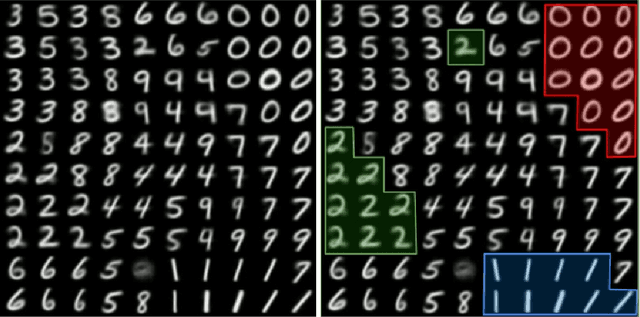
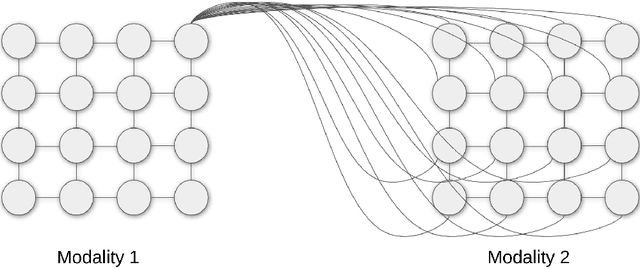
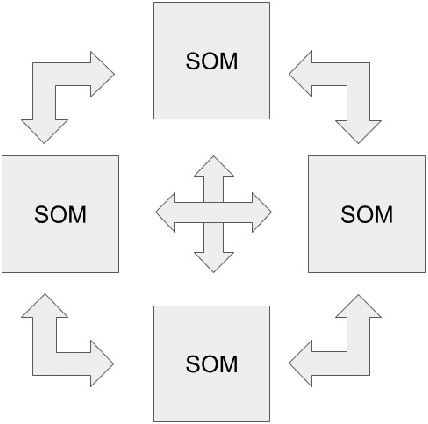

Abstract:The field of artificial intelligence has significantly advanced over the past decades, inspired by discoveries from the fields of biology and neuroscience. The idea of this work is inspired by the process of self-organization of cortical areas in the human brain from both afferent and lateral/internal connections. In this work, we develop an original brain-inspired neural model associating Self-Organizing Maps (SOM) and Hebbian learning in the Reentrant SOM (ReSOM) model. The framework is applied to multimodal classification problems. Compared to existing methods based on unsupervised learning with post-labeling, the model enhances the state-of-the-art results. This work also demonstrates the distributed and scalable nature of the model through both simulation results and hardware execution on a dedicated FPGA-based platform named SCALP (Self-configurable 3D Cellular Adaptive Platform). SCALP boards can be interconnected in a modular way to support the structure of the neural model. Such a unified software and hardware approach enables the processing to be scaled and allows information from several modalities to be merged dynamically. The deployment on hardware boards provides performance results of parallel execution on several devices, with the communication between each board through dedicated serial links. The proposed unified architecture, composed of the ReSOM model and the SCALP hardware platform, demonstrates a significant increase in accuracy thanks to multimodal association, and a good trade-off between latency and power consumption compared to a centralized GPU implementation.
GPU-based Self-Organizing Maps for Post-Labeled Few-Shot Unsupervised Learning
Sep 04, 2020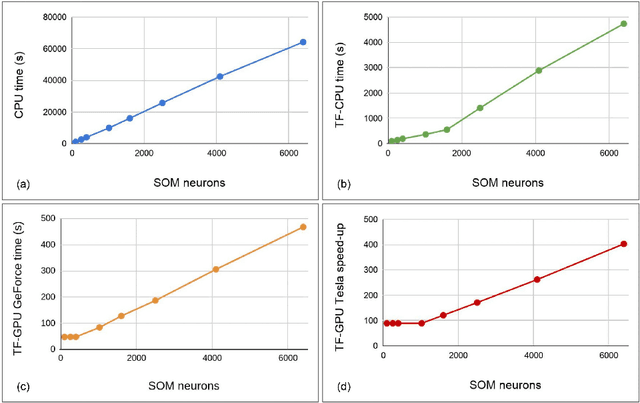

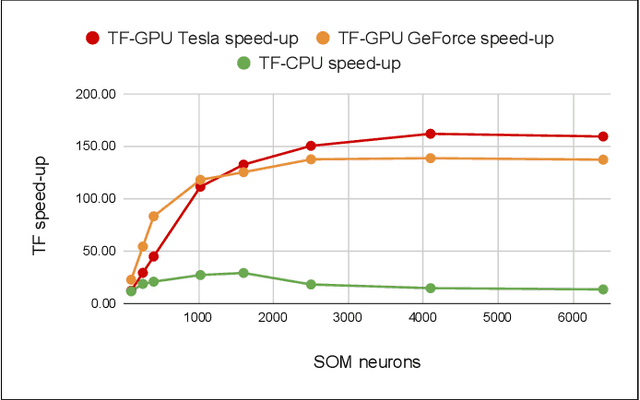

Abstract:Few-shot classification is a challenge in machine learning where the goal is to train a classifier using a very limited number of labeled examples. This scenario is likely to occur frequently in real life, for example when data acquisition or labeling is expensive. In this work, we consider the problem of post-labeled few-shot unsupervised learning, a classification task where representations are learned in an unsupervised fashion, to be later labeled using very few annotated examples. We argue that this problem is very likely to occur on the edge, when the embedded device directly acquires the data, and the expert needed to perform labeling cannot be prompted often. To address this problem, we consider an algorithm consisting of the concatenation of transfer learning with clustering using Self-Organizing Maps (SOMs). We introduce a TensorFlow-based implementation to speed-up the process in multi-core CPUs and GPUs. Finally, we demonstrate the effectiveness of the method using standard off-the-shelf few-shot classification benchmarks.
Improving Self-Organizing Maps with Unsupervised Feature Extraction
Sep 04, 2020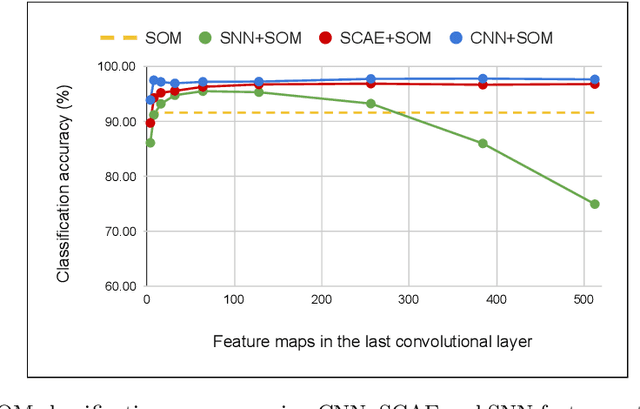

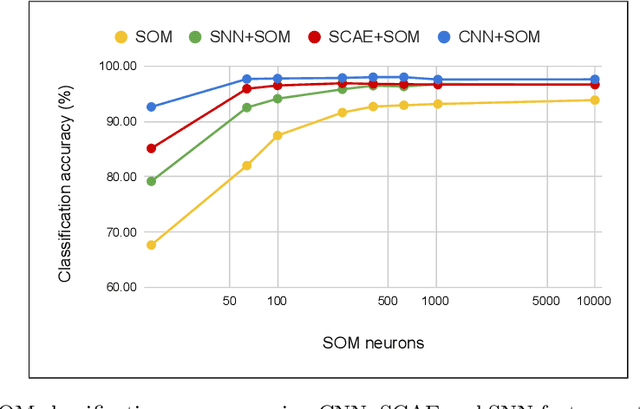
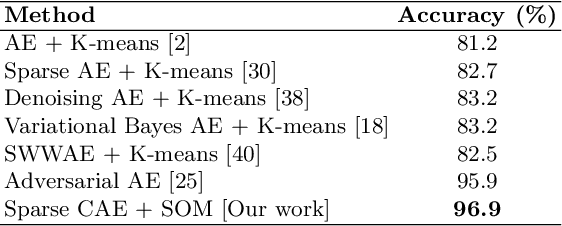
Abstract:The Self-Organizing Map (SOM) is a brain-inspired neural model that is very promising for unsupervised learning, especially in embedded applications. However, it is unable to learn efficient prototypes when dealing with complex datasets. We propose in this work to improve the SOM performance by using extracted features instead of raw data. We conduct a comparative study on the SOM classification accuracy with unsupervised feature extraction using two different approaches: a machine learning approach with Sparse Convolutional Auto-Encoders using gradient-based learning, and a neuroscience approach with Spiking Neural Networks using Spike Timing Dependant Plasticity learning. The SOM is trained on the extracted features, then very few labeled samples are used to label the neurons with their corresponding class. We investigate the impact of the feature maps, the SOM size and the labeled subset size on the classification accuracy using the different feature extraction methods. We improve the SOM classification by +6.09\% and reach state-of-the-art performance on unsupervised image classification.
Brain-inspired self-organization with cellular neuromorphic computing for multimodal unsupervised learning
Apr 11, 2020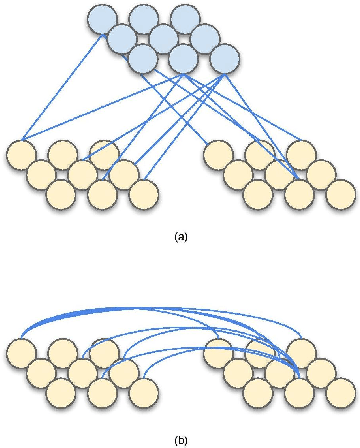
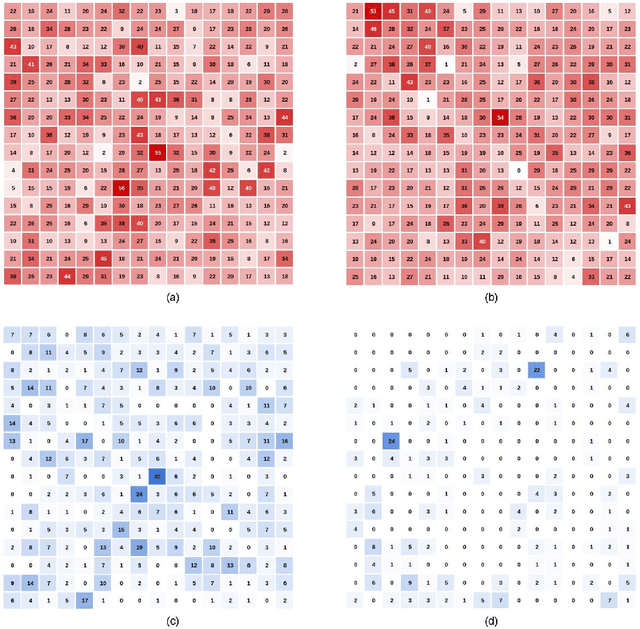
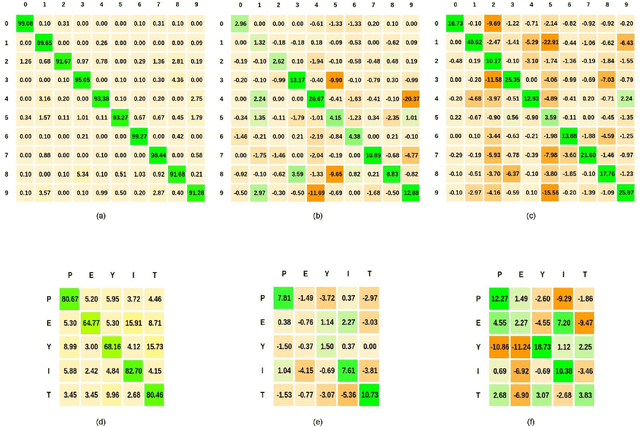
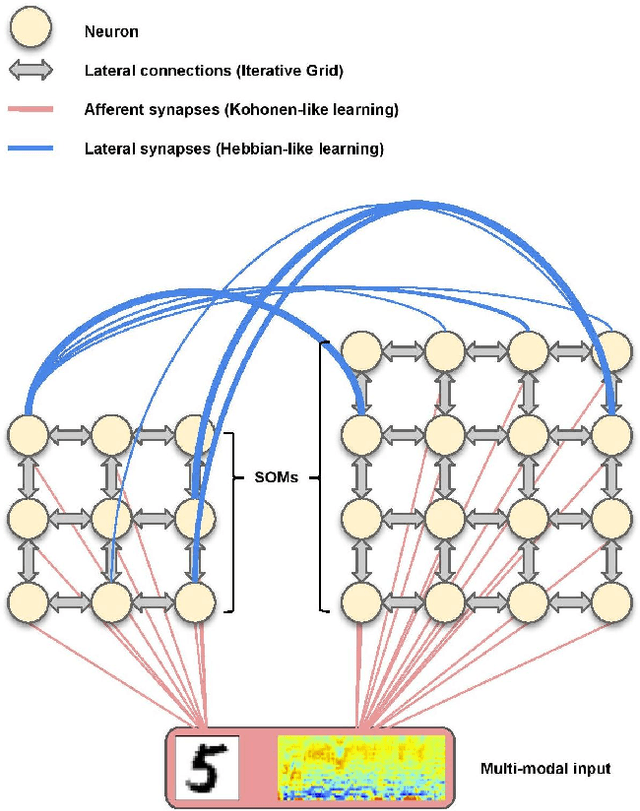
Abstract:Cortical plasticity is one of the main features that enable our capability to learn and adapt in our environment. Indeed, the cerebral cortex has the ability to self-organize itself through two distinct forms of plasticity: the structural plasticity that creates (sprouting) or cuts (pruning) synaptic connections between neurons, and the synaptic plasticity that modifies the synaptic connections strength. These mechanisms are very likely at the basis of an extremely interesting characteristic of the human brain development: the multimodal association. [...] To model such a behavior, Edelman and Damasio proposed respectively the Reentry and the Convergence Divergence Zone frameworks where bi-directional neural communications can lead to both multimodal fusion (convergence) and inter-modal activation (divergence). [...] In this paper, we build a brain-inspired neural system based on the Reentry principles, using Self-Organizing Maps and Hebbian-like learning. We propose and compare different computational methods for unsupervised learning and inference, then quantify the gain of both convergence and divergence mechanisms in a multimodal classification task. The divergence mechanism is used to label one modality based on the other, while the convergence mechanism is used to improve the overall accuracy of the system. We perform our experiments on a constructed written/spoken digits database and a DVS/EMG hand gestures database. Finally, we implement our system on the Iterative Grid, a cellular neuromorphic architecture that enables distributed computing with local connectivity. We show the gain of the so-called hardware plasticity induced by our model, where the system's topology is not fixed by the user but learned along the system's experience through self-organization.
* Preprint, 24 pages, 11 figures, 4 tables
Neuromorphic hardware as a self-organizing computing system
Oct 30, 2018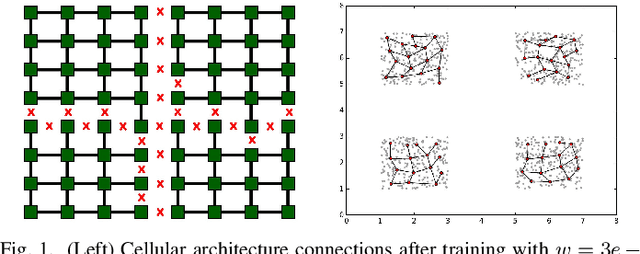
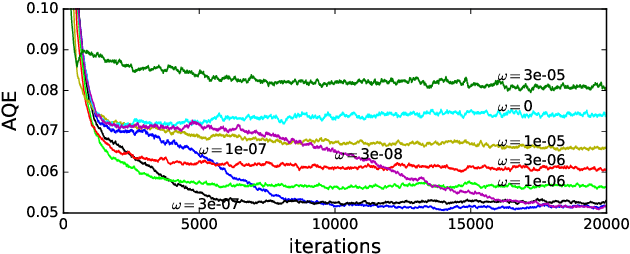
Abstract:This paper presents the self-organized neuromorphic architecture named SOMA. The objective is to study neural-based self-organization in computing systems and to prove the feasibility of a self-organizing hardware structure. Considering that these properties emerge from large scale and fully connected neural maps, we will focus on the definition of a self-organizing hardware architecture based on digital spiking neurons that offer hardware efficiency. From a biological point of view, this corresponds to a combination of the so-called synaptic and structural plasticities. We intend to define computational models able to simultaneously self-organize at both computation and communication levels, and we want these models to be hardware-compliant, fault tolerant and scalable by means of a neuro-cellular structure.
 Add to Chrome
Add to Chrome Add to Firefox
Add to Firefox Add to Edge
Add to Edge